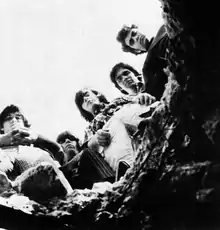Count Five | |
|---|---|
 Count Five in 1966 From left to right: Ron Chaney (bass), Mouse Michalski (lead guitar), Sean Byrne (lead vocals, rhythm guitar), Butch Atkinson (drums), Kenn Ellner (vocals, harmonica) | |
| Background information | |
| Origin | San Jose, California, U.S. |
| Genres | |
| Years active | 1964–1969 |
| Labels | Double Shot |
| Past members |
|
Count Five was an American garage rock band, formed in San Jose, California in 1964, known for their hit single "Psychotic Reaction".
History
The band was founded in 1964 by lead guitarist John "Mouse" Michalski (born 1948, Cleveland, Ohio) and bassist Roy Chaney (born 1948, Indianapolis, Indiana). The two were high school friends who had previously played in several short-lived bands, most notably a surf rock group named The Citations. As the British Invasion's influence took effect, the band changed in musical direction. After going by the name The Squires for a short time, along with several line-up changes, the Count Five was born. John "Sean" Byrne (1947–2008, born Dublin, Ireland) played rhythm guitar and performed lead vocals; Kenn Ellner played tambourine and harmonica, while sharing lead vocals; and Craig "Butch" Atkinson (1947–1998, born San Jose, California) played drums. The Count Five were recognizable for their habit of wearing Count Dracula-style capes when playing live.[4]
"Psychotic Reaction", an acknowledged cornerstone of garage rock,[5] was initially devised by Byrne, with the group refining it and turning it into the highlight of their live sets. The song was influenced by the style of contemporary musicians such as The Standells and The Yardbirds.[6] The band was rejected by several record labels before they got signed to the Los Angeles–based Double Shot Records. "Psychotic Reaction" was released as a single, peaking at number five in the U.S. charts in late 1966,[7] and it became the title track to their only studio album in 1966. The band enjoyed limited success afterwards before breaking up in 1969.
Count Five reunited in April 1987 when they performed a concert at One Step Beyond nightclub in Santa Clara, California. This was released as Psychotic Reunion LIVE!.[8]
Legacy
"Psychotic Reaction" was included on the 1972 compilation album Nuggets: Original Artyfacts from the First Psychedelic Era, 1965-1968.[9] This inclusion was noted as bringing the single and the band to a whole new generation of listeners.[10]
The band was immortalized in a 1971 essay by rock journalist Lester Bangs, entitled "Psychotic Reactions and Carburetor Dung." In the essay, Bangs credited the band for having released several albums after Psychotic Reaction: Carburetor Dung, Cartesian Jetstream, Ancient Lace and Wrought-Iron Railings, and Snowflakes Falling On the International Dateline—each displaying an increasing sense of artistry and refinement. However, none of these subsequent albums existed except in Bangs' own imagination.[11]
"Psychotic Reaction" can be heard playing on the jukebox in an early scene in Wim Wenders' film Alice in the Cities (1974) and in the party scene in The Sense of an Ending (2017). It can also be heard on the season one finale of the HBO drama series Vinyl.[12]
Members
- John "Sean" Byrne – lead vocals, rhythm guitar
- Kenn Ellner – backing and lead vocals, tambourine, harmonica
- John "Mouse" Michalski – lead guitar
- Roy Chaney – bass guitar
- Craig "Butch" Atkinson – drums
- David "Dave" Eugene McDowell lead guitar
Discography
Studio album
- Psychotic Reaction (1966) US No. 122[13]
Compilations
- Dynamite Incidents (1983)
- Psychotic Reaction (1987)
- Rarities: The Double Shot Years (2014)
Live album
- Psychotic Reunion LIVE! (1987)[14]
Singles
- "Psychotic Reaction" / "They're Gonna Get You" (1966) US No. 5[15]
- "Peace of Mind" / "The Morning After" (1966) US No. 125
- "You Must Believe Me" / "Teeny Bopper, Teeny Bopper" (1967)
- "Merry-Go-Round" / "Contrast" (1967)
- "Revelation in Slow Motion" / "Declaration of Independence" (1968)
- "Mailman" / "Pretty Big Mouth" (1969)[5]
References
- 1 2 "The Count Five". AllMusic.
- ↑ Nagelberg, Kenneth M. (2001). "Acid Rock". In Browne, Ray Broadus; Browne, Pat (eds.). The Guide to United States Popular Culture. Popular Press. p. 8.
- ↑ Menezes, Paulo (1 February 2019). "Count Five: Legacy of "Psychotic Reaction"". Medium. Retrieved 4 January 2024.
- ↑ "Count Five Band Photo Gallery". Countfive.com. Archived from the original on July 14, 2015. Retrieved May 11, 2015.
- 1 2 Joynson, Vernon (2007). Fuzz Acid and Flowers Revisited. Glasgow, United Kingdom: Borderline Productions. p. 205. ISBN 978-1-899855-14-8.
- ↑ Bruce Eder. "The Count Five - Biography". AllMusic. Retrieved May 11, 2015.
- ↑ Colin Larkin, ed. (1997). The Virgin Encyclopedia of Sixties Music (First ed.). Virgin Books. p. 129. ISBN 0-7535-0149-X.
- ↑ "Count Five – Psychotic Reunion Live!". Discogs. Retrieved 22 August 2023.
- ↑ "Various - Nuggets (Original Artyfacts from the First Psychedelic Era 1965-1968)". Discogs.
- ↑ "The Count Five Biography by Bruce Eder". AllMusic. Retrieved 22 August 2023.
- ↑ Bangs, Lester (2003). Psychotic Reactions and Carburetor Dung (First ed.). New York: Anchor. pp. 5–19. ISBN 0-679-72045-6.
- ↑ Edwards, Gavin (2016-04-17). "'Vinyl' Season 1 Finale: As Confused as Ever". The New York Times. ISSN 0362-4331. Retrieved 2016-04-18.
- ↑ Whitburn, Joel (2018). Top Pop Albums 1955-2016. Prometheus Global Media. ISBN 978-0-89820-226-7.
- ↑ Internet Archive - Audio Archive: Psychotic Reunion LIVE! (1987).
- ↑ Whitburn, Joel (2015). The Comparison Book Billboard/Cash Box/Record World 1954-1982. Sheridan Books. p. 119. ISBN 978-0-89820-213-7.